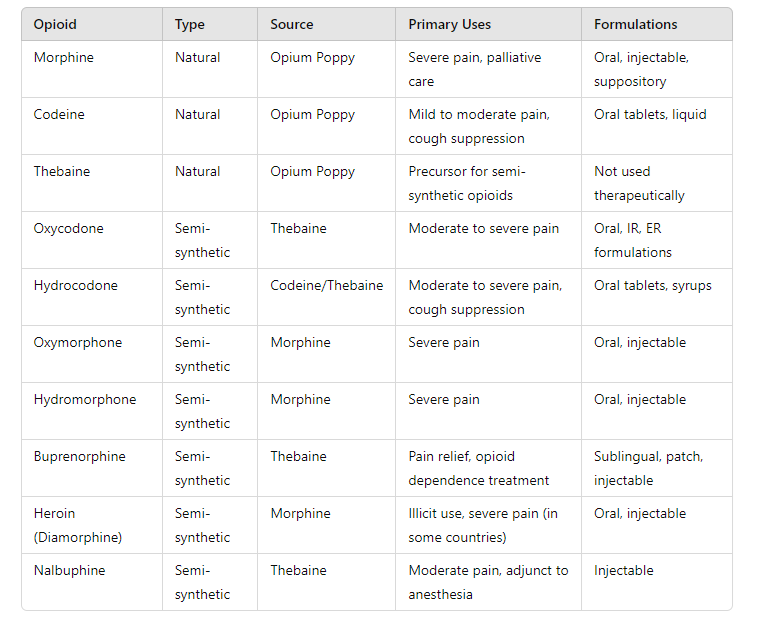Natural and Semi-Synthetic Opioids: A Detailed Overview
Opioids are a class of drugs that are used primarily for pain relief (analgesia). They are divided into three broad categories based on their origin:
- Natural opioids (directly derived from the opium poppy)
- Semi-synthetic opioids (chemically modified versions of natural opioids)
- Fully synthetic opioids (completely man-made)
In this listing, I will focus on natural and semi-synthetic opioids, providing as much detail as possible about each type.

1. Natural Opioids
Natural opioids are alkaloids that are directly extracted from the opium poppy plant (Papaver somniferum). The primary natural opioids are known as opiates,
a. Morphine
- Source: Derived directly from the opium poppy.
- Medical Uses: Morphine is one of the most well-known natural opioids and is primarily used for the relief of severe acute and chronic pain. It is also used in palliative care for end-of-life pain management.
- Formulations: Available in oral (tablet, liquid), injectable, and suppository forms.
- Mechanism of Action: Morphine acts on mu-opioid receptors in the brain and spinal cord to provide pain relief and induce sedation.
- Side Effects: Common side effects include drowsiness, constipation, nausea, and respiratory depression at higher doses.
b. Codeine
- Source: Another natural opioid alkaloid derived from the opium poppy. It is less potent than morphine.
- Medical Uses: Codeine is commonly used for mild to moderate pain and as a cough suppressant. It is also combined with other analgesics such as acetaminophen for enhanced pain relief (e.g., Tylenol with Codeine).
- Formulations: Available in oral tablets, liquids, and combination medications.
- Mechanism of Action: Codeine is partially metabolized into morphine in the liver, which contributes to its analgesic effect.
- Side Effects: Drowsiness, nausea, constipation, and the risk of respiratory depression at higher doses.
c. Thebaine
- Source: Derived from the opium poppy. Unlike morphine and codeine, thebaine is not used directly as an analgesic due to its stimulant effects.
- Uses: Thebaine is primarily used as a precursor for the synthesis of various semi-synthetic opioids such as oxycodone, hydrocodone, and naloxone.
- Effects: In its pure form, thebaine can cause convulsions and is toxic at high doses, which is why it is not used therapeutically.
2. Semi-Synthetic Opioids
Semi-synthetic opioids are chemically modified derivatives of natural opioids, typically morphine or thebaine. They are designed to improve efficacy, potency, or bioavailability, or to reduce side effects compared to natural opioids.
a. Oxycodone
- Source: Derived from thebaine.
- Medical Uses: Oxycodone is used for moderate to severe pain management, including cancer pain and post-operative pain. It is often available in combination with acetaminophen (e.g., Percocet) or in extended-release formulations (e.g., OxyContin).
- Formulations: Available in immediate-release (IR) and extended-release (ER) tablets, as well as oral solutions.
- Mechanism of Action: Oxycodone acts on mu-opioid receptors to relieve pain and produce feelings of euphoria.
- Side Effects: Common side effects include dizziness, nausea, constipation, and respiratory depression.
b. Hydrocodone

- Source: Derived from codeine or thebaine.
- Medical Uses: Hydrocodone is commonly used for moderate to severe pain as well as cough suppression in certain formulations. It is often combined with non-opioid pain relievers like acetaminophen (e.g., Vicodin).
- Formulations: Available in oral tablets, capsules, and syrups.
- Mechanism of Action: Hydrocodone binds to mu-opioid receptors in the central nervous system to reduce pain and suppress cough.
- Side Effects: Sedation, constipation, nausea, and potential for addiction and respiratory depression.
c. Oxymorphone
- Source: A semi-synthetic derivative of morphine.
- Medical Uses: Oxymorphone is used for managing severe pain, particularly in patients who are opioid-tolerant or dealing with chronic conditions such as cancer pain.
- Formulations: Available in immediate-release and extended-release formulations.
- Mechanism of Action: Similar to other opioids, oxymorphone works by activating mu-opioid receptors to produce pain relief and sedation.
- Side Effects: Drowsiness, dizziness, nausea, and the risk of respiratory depression, especially at high doses.
d. Hydromorphone
- Source: A semi-synthetic derivative of morphine.
- Medical Uses: Hydromorphone (brand name Dilaudid) is a potent opioid used for severe pain relief, particularly in cases where morphine may not be effective or is poorly tolerated.
- Formulations: Available in oral tablets, liquids, and injectable forms.
- Mechanism of Action: Hydromorphone is much more potent than morphine and acts on mu-opioid receptors to relieve pain.
- Side Effects: Commonly causes nausea, vomiting, constipation, and respiratory depression at high doses.
e. Buprenorphine
- Source: Derived from thebaine.
- Medical Uses: Buprenorphine is used for pain relief and opioid dependence treatment. It is a partial agonist at mu-opioid receptors, meaning it provides pain relief but with a ceiling effect that reduces the risk of overdose and addiction.
- Formulations: Available as sublingual tablets, patches, injections, and combined with naloxone in formulations like Suboxone for opioid addiction treatment.
- Mechanism of Action: Buprenorphine has a high affinity for mu-opioid receptors but activates them to a lesser degree than full agonists like morphine or oxycodone.
- Side Effects: Similar to other opioids, though less likely to cause respiratory depression due to its partial agonist activity.
f. Heroin (Diamorphine)
- Source: A semi-synthetic derivative of morphine, created by adding two acetyl groups to the morphine molecule.
- Medical Uses: In some countries, heroin is used medically for severe pain and palliative care, but it is mostly known for its illicit use as a recreational drug due to its potent euphoric effects.
- Formulations: When used medically, heroin is available in injectable or oral forms.
- Mechanism of Action: Heroin rapidly crosses the blood-brain barrier and is converted to morphine in the brain, binding to mu-opioid receptors to produce intense euphoria and pain relief.
- Side Effects: High risk of addiction, overdose, and respiratory depression. Heroin use is also associated with significant health risks such as infections, collapsed veins, and long-term damage to organs.
g. Nalbuphine
- Source: A semi-synthetic opioid derived from thebaine.
- Medical Uses: Used for moderate to severe pain and as an adjunct to anesthesia.
- Formulations: Injectable form.
- Mechanism of Action: Nalbuphine is a mixed agonist-antagonist opioid, meaning it acts as an agonist on kappa-opioid receptors (providing pain relief) and as an antagonist on mu-opioid receptors (reducing the risk of euphoria and abuse).
- Side Effects: Drowsiness, dizziness, and less potential for respiratory depression and abuse compared to full opioid agonists.
This list highlights the diversity of natural and semi-synthetic opioids, showing how slight chemical modifications can produce drugs with different potency, therapeutic uses, and side effect profiles.
Pain Medications, Pain Relief, and Pain Management






p4x30z
2g0xvx
tohjn6